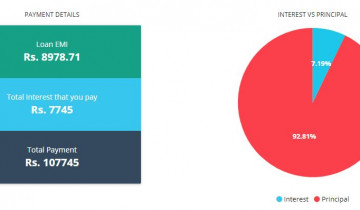Is it a good idea to take loans from others?
Which is a better option – taking a long from a recognized financial institution or going for a loan from a private lender? The answer to that is simple. One should go for the loan that has more chances of getting sanctioned. While most people want to go for a bank loan as they think that it is the only place from where funds can be borrowed, actual facts cannot be further from the truth.
So why does everyone want a loan from a recognized financial institution in India? It is because their interest rates a relatively lower compared to private lenders.
Why do bank loans offer lower rates?
Recognized financial institutions in India such as banks – both public and private, along with non-banking financial institutions have a lower cost of funds in comparison to private players. Their retail customers, that is, depositors have accounts where they keep funds in their savings and current accounts. Banks have access to these funds that they use to lend to prospective loan applicants – individuals or businesses. Since banks give an extremely low rate of interest to the depositor on the funds that he or she keeps in their savings and current accounts, using these funds to approve loans is more profitable for the financial institutions.
In addition to the funds from the bank’s retail customers, they have access to funds from the Reserve Bank of India too.
Compared to banks, private lenders have to look for investors who in turn are looking to get a higher return on their investment in comparison to investing in other financial prospects. Therefore, private lenders have to levy a higher interest rate as they in turn have to attain a profit on the transaction before returning the funds back to an investor with interest.
For example, a financial institution needs to earn 6% on their loans in order to have adequate coverage to meet the financial institution’s direct expenditures such as their cost of being in business. If they can acquire these funds at a low interest of 1.25% and lend it out at, let’s say 7.25%, they are able to meet their target.
On the other hand, a private lender may only require, let’s say, 4% to meet their operating costs. However, they have to lend the funds to the borrower at 10% in order to repay the investor at 4% and make a small profit of 2% on the transaction. If the private lender charges anything less than 10%, it will soon go out of business.
So, it is easy to see why a prospective borrower will ideally want to get a bank loan as opposed to going for a loan from a private lender.
But, banks are also opportunistic too.
Even though financial institutions can offer a much lower interest on the loans that they sanction, in the majority of cases, that never happens. Here’s why:
The only competition for these financial institutions is private lenders and financial institutions are aware of the fact that private lenders cannot charge less than 10%. Therefore, to get maximum mileage, financial institutions charge 9% – 9.5% and are still able to beat the competition.
Additionally, financial institutions also have other methods of revenue generation. While loans are a huge part of this revenue generation process, there are other ways by which they can make money, for example, banking fees, investing depositor funds in stocks and bonds, making acquisitions, etc.
A borrower has to encounter stiff regulations when it comes to getting a bank loan approved. Thus, many individuals, small and medium sized businesses are unable to meet these eligibility criteria and therefore are unable to qualify for bank loans. Most regulations include an existing credit history with the bank, a positive credit score, stable employment status and low debt to income ratios.
On the other hand, private lenders do not have these strict regulations in place. Since their only way of revenue generation is through lending, they do not make it difficult for borrowers in terms of eligibility or paperwork compliances.
From a borrower’s perspective, it is easier to get loans from private lenders as they can bypass the eligibility and documentation processes. However, it is a double-edged sword as interest rates are higher.
So, going back to the original question – is it a good idea to take loans from others? The answer still remains the same – it depends on who grants the loan to the borrower.
Still want a bank loan, but don’t qualify?
To ensure that you qualify for a bank loan, work towards growing your business or ensure that your employment and credit history are positive. However, if you need immediate access to funds, private lenders are your only way out.
There are two things that you should keep in mind:
- Given the overall scheme of things, the difference between 10% from a private lender and bank’s 9 or 9.5% interest rate, for a short-term period will not make a huge dent in terms of payout.
- If you need immediate funds, then private lending is the way to go. As long as you are able to repay the loan within the scheduled timelines, you don’t have to worry about it too much.
Therefore, when seeking a loan, run a check on your eligibility and credit history before approaching the lending medium – be it a bank or a private lender.
Get More Info about P2P Lending




